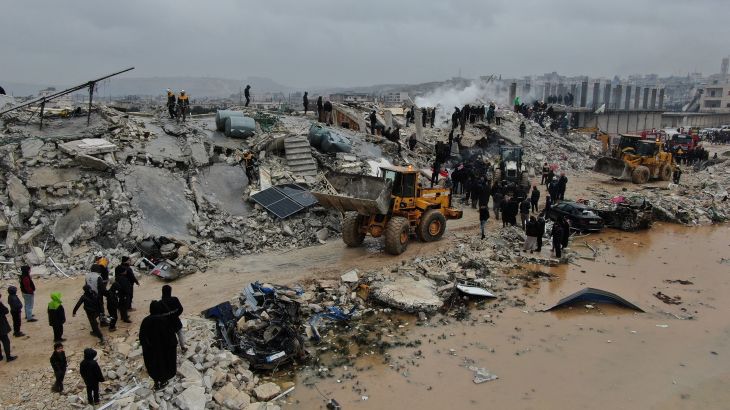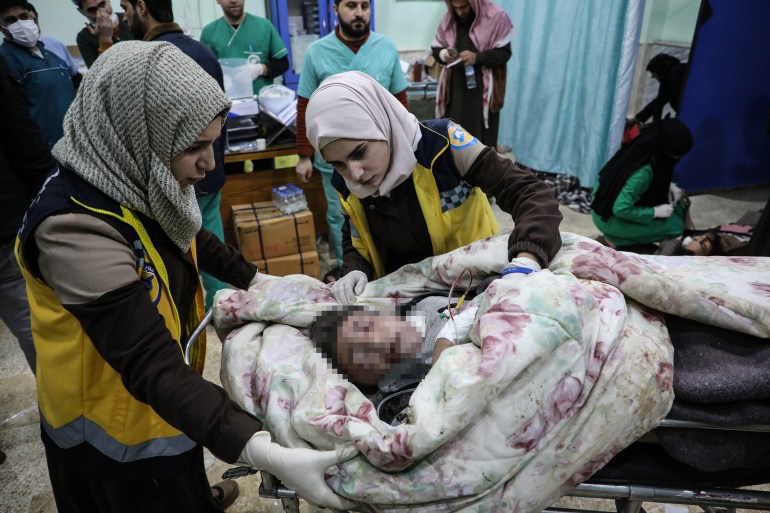In war-ravaged Idlib, devastating quake feels like ‘Doomsday’
Thousands are left homeless in opposition-held parts of Syria after a major earthquake as infrastructure already weakened by bombings falters.

Idlib, Syria – It was well before dawn when a violent shaking jolted Muhammad Alloush from his deep sleep.
“Our house oscillated like the waves of the sea,” recalled the 60-year-old, an internally displaced person from the Syrian city of Homs who currently lives in Sarmada, an opposition-held city near Syria’s border with Turkey.
Keep reading
list of 4 itemsWhy have the Turkey-Syria earthquakes been so deadly?
Turkey’s Gaziantep goes from a refuge to a site of devastation
Photos: Deadly quake intensifies suffering of displaced Syrians
At 4:17am (01:17 GMT) on Monday, a magnitude 7.8 earthquake rocked southeastern Turkey and northwestern Syria, causing widespread death and destruction.
Thousands of people have so far been reported dead with thousands more injured as buildings collapsed in towns and cities across the neighbouring countries and on both sides of the front line separating government-held parts of war-hit Syria from opposition-controlled areas.
This is the moment rescue teams in northern Syria pulled a child from under the rubble of a collapsed building after a magnitude 7.8 earthquake ⤵️ pic.twitter.com/8TNpapvYtU
— Al Jazeera English (@AJEnglish) February 6, 2023
“As we were evacuating the house, it started to come apart,” Alloush, a father of eight, told Al Jazeera.
“My hand was injured by falling debris while I was protecting my granddaughter, which delayed our exit from the house and I consequently suffered a number of other minor injuries,” he said.
With tears in his eyes, Alloush said members of two other families living in the same building were not able to make it out in time.
“I hope my neighbours will be rescued,” he added.
“The fear we witnessed today can only be described as akin to Doomsday.”
‘Working around the clock’
The devastating tremor, whose epicentre was in the Turkish province of Kahramanmaras, has forced survivors across the Idlib region and the northern countryside of Aleppo to take refuge in the streets and public squares amid freezing weather conditions.
Children, women and the elderly slept in the open air without any heat sources to protect them from the cold, while many young men went to help rescue teams search for survivors under the rubble of collapsed structures.
Members of the Syria Civil Defence, or White Helmets, a rescue group operating in opposition-held parts of Syria, said the northwestern region’s existing infrastructure was already weakened by incessant bombardment.
“Our teams are working around the clock to save those trapped under the rubble of destroyed buildings. More than 133 buildings were completely destroyed and 272 were partially destroyed, while thousands others are no longer structurally sound,” Ismail Abdullah, a volunteer rescue worker, told Al Jazeera.
As civil defence and volunteer teams continued to search for survivors, pressure was mounting on hospitals in northwestern Syria, which are not equipped to treat a large number of injuries.
"Many families are under the rubble."
A rescue worker in rebel-held northwest Syria has called on the international community for urgent help after a deadly 7.8-magnitude earthquake ⤵️ pic.twitter.com/pKZH8L5cZo
— Al Jazeera English (@AJEnglish) February 6, 2023
Dr Osama Abu al-Ezz, field director at the Syrian American Medical Society (SAMS), a non-profit that provides humanitarian assistance to Syrians, described the earthquake as catastrophic.
“In SAMS hospitals, we treated more than 550 people who were injured by debris of destroyed homes, and we received the bodies of 120 people,” he said.
Abu al-Ezz called for concerted efforts to boost existing capabilities to treat the injured, who are expected to increase in numbers as search and rescue operations continue. Rescue workers and rights groups also called on the international community to take measures to provide aid to survivors and save civilians.

“In the midst of a winter storm and an unprecedented cost-of-living crisis, it is vital that Syrians are not left to face the aftermath on their own,” the Norwegian Refugee Council said in a statement, warning that the catastrophe would exacerbate living conditions for a population already struggling with the devastating impact of nearly 12 years of conflict.
“Millions have already been forced to flee by war in the wider region and now many more will be displaced by disaster.”